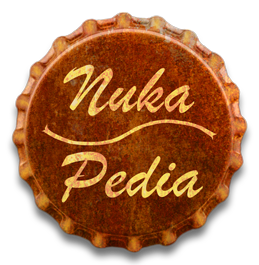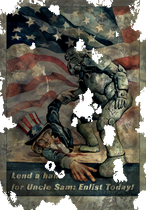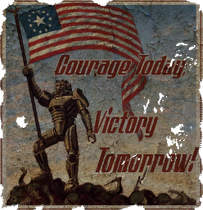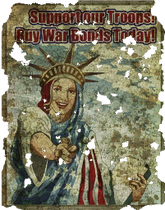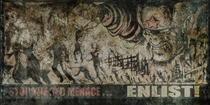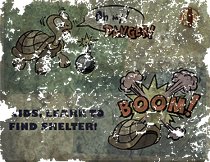The United States of America (U.S.A.), or simply the United States (U.S.), was a federal republic in North America. It was one of the last surviving economies in the wake of the mid-21st century's global energy crisis, and one of the primary nuclear participants in the Great War.
The Enclave was founded by and is descended from remnants of the nation's original government and claim to be the true continuation/successor to the United States. But they are not representative of the national identity as a whole, being an immoral organization created by and exclusively serving the interests of a specific, shadowy element of the original government.[1]
Of attempts by more down-to-Earth wastelanders to reestablish the original ideals and values of the United States, the most successful has been the New California Republic.
The American Commonwealths
Beginning sometime in 1969[2], the United States of the Fallout universe had an intermediate level of government between the 50 states and the federal government. The nation was divided into 13 commonwealths, the same year the Virgo II mission landed Americans on the Moon in July. The United States flag was changed as well to reflect the new political reality. Accordingly, the new flag depicted thirteen stars to represent the commonwealths.
The commonwealths reserved certain powers that used to belong to states; issuing license plates and establishing preservation areas being among those seen. The states, however, still possessed a certain level of sovereignty within their commonwealth. Each state still had its own flag (although modified to show its status within its commonwealth), and state lines were still quite relevant. Additionally, a state was listed as the place of production on the package pre-war MREs rather than a commonwealth.
It was hoped that the new administrative division of the country would help create legislation broad enough to benefit those states with common regional concerns, but narrow enough not to affect those states with dissimilar interests or political cultures, which would help the nation better meet the challenges posed by the Communist threat to American democracy. In reality, it created even more political strife in the American government, as commonwealths typically did everything they could to promote their own interests at the expense of other commonwealths. The thirteen American commonwealths were:
| Commonwealth | Regions |
|---|---|
| Columbia Commonwealth | Washington, D.C., Maryland, Virginia |
| East Central Commonwealth | Ohio, Kentucky, Tennessee |
| Eastern Commonwealth | West Virginia, Delaware, Pennsylvania, New Jersey, New York |
| Four States Commonwealth | Utah, Colorado, Arizona, New Mexico |
| Gulf Commonwealth | Louisiana, Mississippi, Alabama, Florida |
| Great Midwest Commonwealth | Wisconsin, Minnesota, Illinois, Indiana, Michigan |
| New England Commonwealth | Maine, New Hampshire, Vermont, Massachusetts, Rhode Island, Connecticut |
| Northern Commonwealth | Montana, Wyoming, North Dakota, South Dakota |
| Northwest Commonwealth | Northern California, Washington, Oregon, Idaho, Alaska |
| Plains Commonwealth | Nebraska, Kansas, Iowa, Missouri, Oklahoma |
| Southeast Commonwealth | Georgia, South Carolina, North Carolina |
| Southwest Commonwealth | Southern California, Nevada, Hawaii |
| Texas Commonwealth | Texas, Arkansas |
Canada
It is unknown whether there were any changes to this system of commonwealths after the annexation of Canada in 2076. It is possible that Canada was under military rule until annexation was finalized (2076). Because of the relatively small size of its population (about one-tenth the size of the U.S.), Canada would have been equal in size to a single, large American commonwealth. Border changes were also possible, e.g. concerning Alaska and the pipelines.
Mexico
The U.S. Army invaded Mexico in 2051 to annex it, wanting their business interests and oil supply, but a consensus on the goals of the war was never reached.
Other territories
The United States held other territories in the world, mostly throughout the Caribbean Sea and the Pacific Ocean, however, the status of these holdings is unknown.
Federal Government
The pre-War federal government of the United States was not too different from that of 21st-century America in our own universe, albeit significantly less democratic by the mid-21st century. Agencies of the federal government mentioned in the games include two concerned with military affairs: the War Department and the Department of Defense, which may have actually been the same agency or, if they were separate entities, were both responsible for overseeing the development of various military research projects, from HERMES to T-51b power armor.
Other federal agencies mentioned in the games are the Department of Energy (or Water and Power), the Federal Bureau of Investigation (FBI), Unamerican Activities Force, Secret Service, Bureau of Alcohol, Drugs, Tobacco, Firearms and Lasers, the United States Space Administration, Federal Fitness Registry, the National Catastrophe Relief Auxiliary, United States Geological Survey and the Defense Intelligence Agency (CIA). The legislative branch of the federal government was still composed of the House of Representatives and the Senate, though whether they still represented the individual states or now represented the different American commonwealths in some form is unknown.
Armed Forces
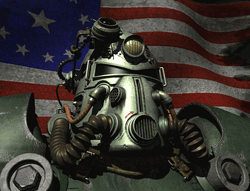
A United States soldier in power armor in front of the U.S. flag.
Before the Great War, the United States Armed Forces were the overall unified military forces of the United States, composed of the Army, Navy (and its subsidiary Marine Corps), Coast Guard and Air Force. The President of the United States served as the commander-in-chief of the American military, with the Department of War (sometimes called the Department of Defense) acting as the principal organ by which military policy was carried out.
After the Great War, the Enclave Armed Forces are the direct descendant of the American military. The Brotherhood of Steel, on the other hand, was started by former U.S. Army soldiers who rebelled against their unethical orders to protect scientists carrying out involuntary mutational experiments on military prisoners.
The Enclave
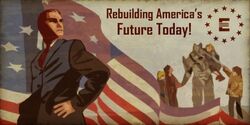
Enclave propaganda poster.
Members of the Enclave both embraced the idea of a nuclear war and knew that the common man could not survive it. They believed that as long as the "important people" of the United States survived, they could regroup quickly and wipe out Communism once and for all. Though not technically part of the Enclave, many powerful corporations benefited from the Enclave's actions, and their research facilities were protected during the nuclear firestorm of 2077.
In 2073, as the global race to exploit the handful of remaining fossil-fuel resources reached its fevered peak, the United States managed to stake a claim on the world's last known supply of crude oil, buried thousands of feet beneath the Pacific Ocean. Poseidon Energy, a major American energy company, was contracted to build an oil rig and extract the oil. Before long, the oil ran dry and the oil rig was abandoned by Poseidon.
In 2077, with total nuclear war imminent, the President of the United States and a number of other American government officials left their posts in Washington, D.C. to take refuge in a number of secret and isolated locations around the United States. Among them was the Poseidon Oil Rig off the coast of California. Here, the President himself set up a secret base from which the United States could continue to exist and wage war on China, with the eventual goal of retaking the continental United States from its post-atomic state. From 2077 on, the remnant of the American government surviving on this oil rig started to openly call itself the Enclave. In dialogue with Arcade Gannon, in Fallout: New Vegas, it is revealed that after the Fall of the Oil Rig, the NCR eventually overran Navarro. This caused all Enclave forces in the West to scatter or head to the east. There, the Enclave set up bases in Raven Rock and Adams Air Force Base, and according to ED-E, outposts in Chicago. The base in Raven Rock was later destroyed in 2277.
The Enclave mostly continued the pre-War American government, making alterations to fit their smaller size and increase the fluidity of operations. Some new departments that were established after the Great War included the Atomic Energy Commission and the Chemical Corps.
Background
The End of America
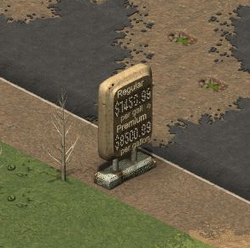
US gas prices in 2077 (per gallon):
Regular - $7450.99
Premium - $8500.99
Ever since the end of World War II in 1945, the United States in the Fallout universe had sought to become the sole remaining superpower in the world, aiming to control the globe's major energy resources and influence the direction of life in other nations. In the twenty-first century this became more apparent as the Resource Wars raged between the European Commonwealth and the oil-rich states of the Middle East, the United Nations disbanded in acrimony, and the Soviet Union slowly declined. The United States found itself with no real rival on the global scene except the People's Republic of China, though it was economically and militarily behind America at first. However, the energy crisis of the mid-twenty-first century hit the United States harder than expected, compounded by the outbreak of the New Plague in 2053. In 2054, a nuclear exchange in the Middle East prompted the American government to establish Project Safehouse, which was intended to create 122 underground fallout shelters that would save a portion of American society from the ravages of nuclear war or an unstoppable global pandemic. Five years later, in 2059, in order to protect its Alaskan oil interests, the United States established the Anchorage Front Line, to defend its stockpiles of oil from potential invaders.
In 2060, stockpiles of oil ran dry and the pursuit of the last underground reservoirs of petroleum emptied the American economy. People pushed their cars around and the political pressure to research alternative sources of energy increased enormously. To maintain its status as a superpower in spite of the crisis the United States expanded the size of its military and commissioned a government defense contractor, West Tek, to create powered infantry armor, intended to replace tanks on the battlefield. This project eventually proved to be the salvation of American industry, and, in the summer of 2066, the first crude nuclear fusion cell was developed as part of this research effort and was then adapted to civilian needs.
This fact, coupled with American unwillingness to share the world's last untapped oil field in the Pacific Ocean with other energy-starved nations, prompted China to declare open war against the United States and invade Alaska in 2066, initiating the Sino-American War. The initial Chinese campaign was successful, but soon Chinese and American soldiers found themselves bogged down in a war of attrition, with both sides unable to gain any sort of meaningful advantage over the other. Even the mighty American T-45d power armor units did not tip the scales, as China's Crimson Dragoon units rampaged behind American lines, disrupting the U.S. Army's logistics and transport.
The United States' northern neighbor, Canada, proved unwilling to accept the increasingly aggressive behavior of the United States as it fought to repel the Chinese invasion. Faced with almost open hostility and the threat of military action, Ottawa relented, allowing American troops and aircraft to pass freely through its territory. This led directly to the annexation of Canada by the United States in 2076.
War and the energy crisis took a toll on American citizens. Together with the development of the Forced Evolutionary Virus (FEV) being leaked to the mainstream news, the citizens became increasingly restless as the global and national situation deteriorated, throwing the country into turmoil. The U.S. Army was deployed into major American urban centers to contain riots in the year just before the Great War, leading to the American Army firing on its own commanders in certain circumstances.
Post-War America
Despite it all, humanity survived the atomic catastrophe. Even the American federal government managed to survive as the Enclave, the only known remnant of any pre-War government in the Fallout universe.
Surviving American citizens, particularly in what had once been the state of California, soon started rebuilding and eventually established the New California Republic.
The USA will be habitable by 2377, as stated in the Vault 101 PA System. It is likely, however, that this was a miscalculation or a lie.
The Flag
Cowpens Flag
The United States of the Fallout timeline, at least since the formation of the thirteen American commonwealths in the mid-twentieth century, uses a flag with either 12 or 13 stars in a circle, with one large central star.
Although Fallout 3's final version of 12 stars surrounding a 13th most closely resembles an obscure flag known as the Cowpens Flag, the flag with a circle of stars referenced by Fallout's opening cinematic is the considerably better known 'Betsy Ross' Flag. A flag with 13 stars and stripes, one for each of the original U.S. states, was mandated by the Second Continental Congress' Flag Resolution of 1777. As states were added to the Union, more stars were successively added to the flag until the flag of 50 stars was created in 1960.
The Cowpens was an American Revolutionary War-era flag used in the Battle of Cowpens, South Carolina in 1781 that resulted in one of the major victories of the young nation over its British mother country. The only difference between the Cowpens and Fallout flags is a much enlarged middle star used on the American flag in the Fallout universe, probably to represent the nation as a whole.
Appearances
All Fallout games to date have been set exclusively within United States territory, but following the collapse of civilization, in most cases this territory is now either claimed by other groups, or not governed at all. Ruins/relics of now long-defunct government institutions are seen all throughout the series.
The prologue sequence of Fallout 4 takes place in the United States' final moments as a properly functioning nation.
The Enclave appear as a major enemy faction in Fallout 2 and Fallout 3 and are mentioned, with a handful of retired members appearing, in Fallout: New Vegas.
Newsreel footage of the US Army in action is present in Fallout.
Operation: Anchorage is set in a recreation of Alaska and features simulated, fictionalized representations of the U.S. Army.
Behind the scenes
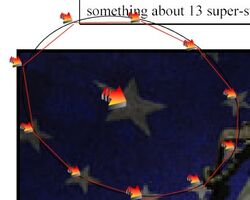
Red's "correction".
The initial idea of dividing the country into thirteen zones came from Leonard Boyarsky during the development of Fallout. In Fallout Bible 8, Tim Cain reported that Leon said he used that flag because it "looked cool" and he didn't want to use a standard U.S. flag with 50 stars. Eventually, he planned to make up something about 13 super-states, but he never did. It was further elaborated upon by J.E. Sawyer, who broke up the U.S. into Commonwealths.
There is much misunderstanding about the number of stars on the flag and the corresponding zones, because not all of them are actually visible in the only available picture depicting it. Chris Avellone stated that there are 13 of them in Fallout Bible 8. He was "corrected" by Red, who sent him the picture with the location of 11 stars marked. In 2005, J. E. Sawyer tried to clarify the issue by saying that according to Tramell Ray Isaac, who rendered the intro cinematic for Fallout said that they just took the old colonial flag with 13 stars in a circle and added a new star in the middle.
Sawyer's explanation was widely accepted until 2008, when Bethesda Softworks released Fallout 3, which featured a flag with 12 stars in a circle and one in the middle, effectively establishing (or, alternatively, retconning) this version of the flag as the "true" version. This version of the flag also appears in Fallout: New Vegas.
As of the 2015 release Fallout 4, Bethesda Softworks seem to have noticed the discrepancies regarding the flag and have adjusted it to have thirteen stars surrounding a large, central star once more. Neither the original mistake nor the subsequent fix have been officially explained by Bethesda.
Gallery
References
- ↑ A. Ron Meyers, Fallout 2, Fcronmey.msg, {118}{}{I used to serve with the Enclave. Then I realized it wasn't the USA I was fighting for; it was for the rich old bastards who didn't want to give up their power. I deserted and now I live here with more honest people.}
- ↑ Plaque on the Massachusetts State House in Fallout 4 gives 1969 as the formation date of the "Thirteen commonwealths"
| |||||||||||||||||||||||||||||||||
